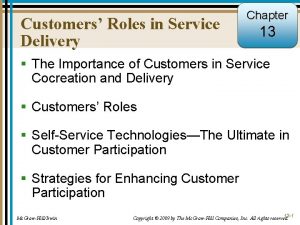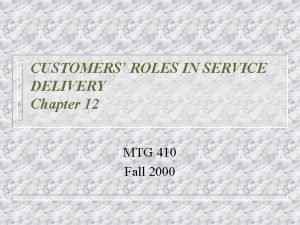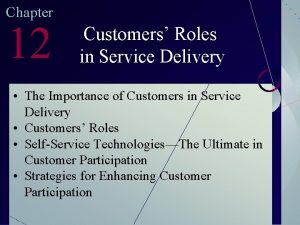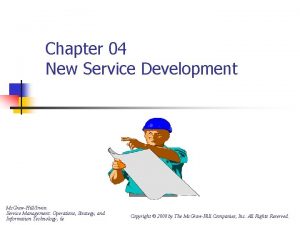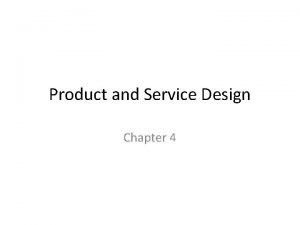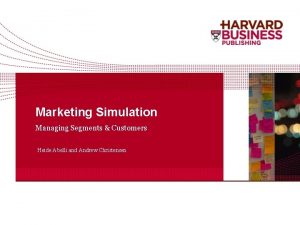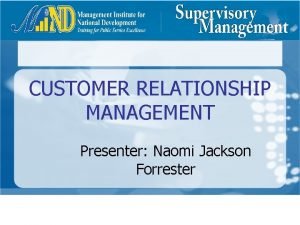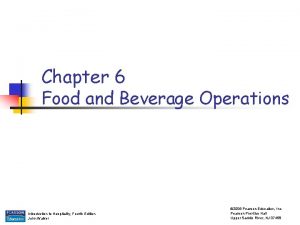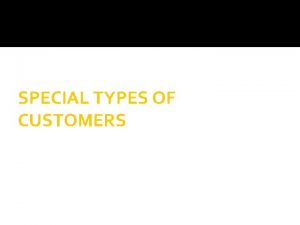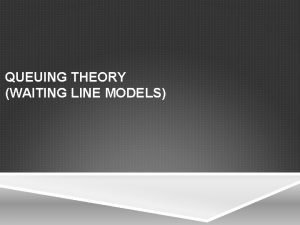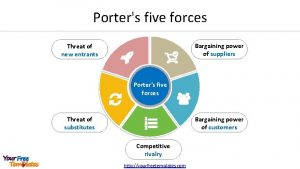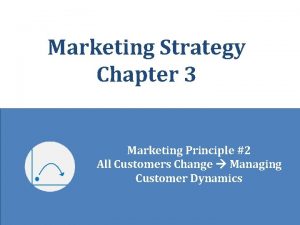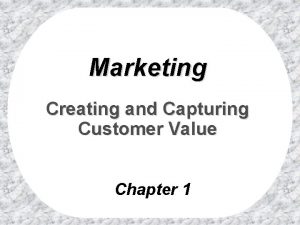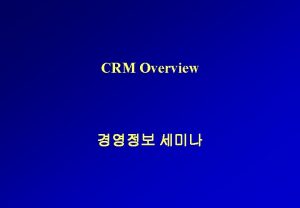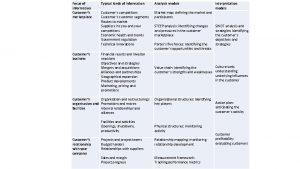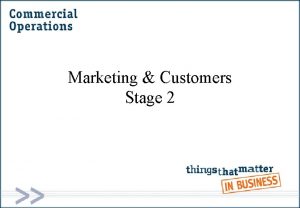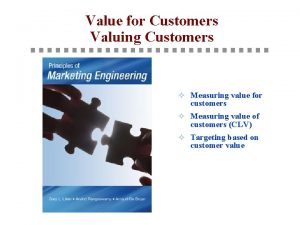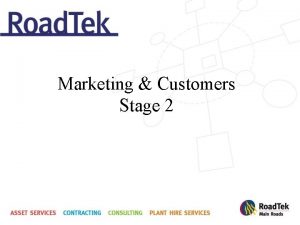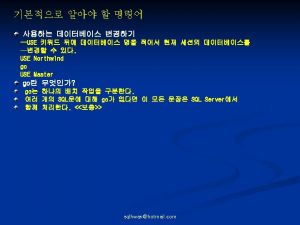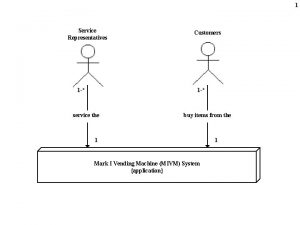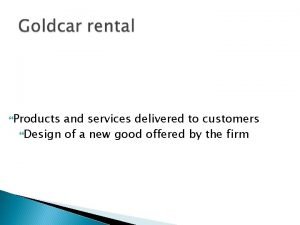Service design and development Introduction Customers perspective Services




































- Slides: 36

Service design and development

Introduction • Customers perspective Services =expereinces • Organizations perspective – services = designing n managing the services ie. Technique for displaying the nature, methods and sequence of the different steps in delivery service to customers – better way to understand total customer service experience and giving value preposition promised to the customer – Poorly designed services will annoy the customers, front end people leading to ^ service failures

• Flowcharts: – Is a simplest tool that documents the nature and sequences of different stages / encounters involved In delivering the services to customers • Shows how nature of customer involvement with service organizations varies by type of service: – – People processing Possession processing Mental Stimulus processing Information processing

Flowcharts for People and Possession Processing Services

Flowcharts for Mental Stimulus and Information Processing Services

Blueprinting Services to Create Valued Experiences and Productive Operations

Service Blueprinting • A tool for simultaneously depicting the service process, the points of customer contact, and the evidence of service from the customer’s point of view. • more sophisticated version of flowcharting 8 -7

Developing a Blueprint 1. Identify key activities in creating and delivering service 2. Define “big picture” before “drilling down” to obtain a higher level of detail 3. Distinguish between “front stage” and “backstage” 4. Clarify interactions between customers and staff, and support by backstage activities and systems 5. Identify potential fail points; take preventive measures; prepare contingency 6. Develop standards for execution of each activity— time for task completion, maximum wait times, and scripts to guide interactions between employees and customers

Service Blueprint Components Physical Evidence Customer Actions line of interaction Visible Contact Employee Actions line of visibility Invisible Contact Employee Actions line of internal interaction Support Processes 8 -10

Service Blueprint Components 8 -11

Setting Service Standards and Targets • What cannot be measured is not managed. • Different level of service expectation – Desired service • Hope/wished to receive • Can and should deliver • Expectation rests on : explicit n implicit promises done – Adequate service: • Minimum level of service without dissatisfaction

• Predicted service – Customer actually anticipates – 10 mints wait for cab in peak hour • Zone of tolerance – Difficult to provide consistent service – Range within which the customer don’t pay explicit attention (+ or -) – advocate

Setting Standards and Targets for Customer Service Processes Service Attributes Service Process Indicators Service Process Standards Performance Targets 24 hours 80% of all • Responsiveness • Reliability Processing time • Competence to approve • Accessibility applications in 24 hours • Courtesy • Communication • Credibility Creates a Base to Define/Process • Confidentiality Define Service Measure Customer Departmental • Listening to the Quality Goals for Satisfaction Staff Service Goals customer

Snippets about research • First impression is important – Affects customer’s evaluations of quality during later stages of service delivery as customer perceptions of service experiences tend to be cumulative • Research by Marriott Hotels: four of five top factors contributing to customer loyalty come into play during the first 10 minutes of service delivery • Performance stds should not fall off during the end of the service delivery.

• poor start followed by good service recovery is rated better than one that starts well and ends poorly • For low-contact service, a single failure committed front stage is relatively more serious than in a high-contact service because there are fewer subsequent opportunities to create a favorable impression

Redesigning Service Processes

Why Redesign? “Institutions are like steel beams—they tend to rust. What was once smooth and shiny and nice tends to become rusty. ” Mitchell T. Rabkin, MD, former president of Boston’s Beth Israel Hospital

Why Redesign? • Revitalizes process that has become outdated • Changes in external environment make existing practices obsolete and require redesign of underlying processes • Rusting occurs internally – Natural deterioration of internal processes; creeping bureaucracy; evolution of spurious, unofficial standards – Symptoms: • • - Extensive information exchange - Data that is not useful - High ratio of checking control activities to value-adding activities Customer complaints about inconvenient and unnecessary procedures

Redesign to. . ? • Redesign aims to achieve these performance measures: – Reduced number of service failures – Reduced cycle time from customer initiation of a service process to its completion – Enhanced productivity – Increased customer satisfaction

Process Redesign: Approaches and Potential Benefits) Eliminating non-valueadding steps Delivering direct service • Streamline front-end and back-end processes of services with goal of focusing on benefitproducing part of service encounter • Eliminate non-value-adding steps • Improve efficiency • More customized service • Differentiate company • Bring service to customers instead of bringing customers to provider • Improve convenience for customers • Productivity can be improveed • retail locations • Increase customer base

Shifting to self-service Bundling services • Increase in productivity and service quality • Lower costs and perhaps prices • Enhance technology reputation • Greater convenience • Fed ex shited 50% of its business from call centre to website thus reducing 20000 employees • Involves grouping multiple services into one offer, focusing on a well-defined customer group • Often has a better fit to the needs of target segment • Increase productivity • Add value for customers through lower transaction costs • Customize service • Increase per capita service use • One bank token.

Redesigning physical aspects of service processes • Focus on tangible elements of service process; include changes to facilities and equipment to improve service experience • Increase convenience • Enhance the satisfaction and productivity of frontline staff • Cultivate interest in customers • Differentiate company

The Customer as Co. Producer

Levels of Customer Participation High – Customer works actively with provider to co-produce the service • Service cannot be created without customer’s active participation • Customer can jeopardize quality of service outcome* cricket academy Medium – Customer inputs required to assist provider • Provide needed information and instructions • Make some personal effort; share physical possessions*payroll service Low – Employees and systems do all the work • Involves standardized work*pest control, bus service

Customers as Partial Employees • Customers can influence productivity and quality of service processes and outputs • Customers not only bring expectations and needs but also need to have relevant service production competencies • For the relationship to last, both parties need to cooperate with each other

Managing Customers • Recruit customers that possess the competency to Recruitment and Selection perform the necessary tasks Job Analysis Education and Training • Are customers aware of their roles and equipped with the required skills? • Information required for them to perform their roles via instructions or video demonstration Motivate • Ensure that they will be rewarded for good performance Appraise • For sub-par performances, improve customer training or change the role or process Ending • Last resort: if customer is non compliant consider termination of the relationship

Challenge: Getting customers to try this technology

Managing Customer’s Reluctance to Change • Increasing customer’s participation level in a service can be difficult • Marketing communications to be used to: – Prepare customer for change – Explain the rationale and benefits – What customers need to do differently in the future

Dysfunctional Customer Behavior

Addressing the Challenge of Jaycustomers • Jaycustomer: A customer who behaves in a thoughtless or abusive fashion, causing problems for the firm, its employees, and other customers • More potential for mischief in service businesses, especially when many customers are present • Divergent views on jaycustomers – “The customer is king and can do no wrong. ” – Marketplace is overpopulated with nasty people who cannot be trusted to behave in ways that self-respecting services firms should expect and require • No organization wants an ongoing relationship with an abusive customer

Six Types of Jaycustomers: 1. The Thief • No intention of paying—sets out to steal or pay less • Services lend themselves to clever schemes to avoid payment – For example: bypassing electricity meters, circumventing TV cables, riding free on public transportation • Firms must take preventive actions against thieves, but not alienate honest customers by degrading their service experience – Make allowances for honest but absent-minded customers

2. The Rulebreaker • Many services need to establish rules to guide customers safely through the service encounter • Government agencies may impose regulations that service suppliers must enforce • Some rules protect other customers from dangerous behavior – For example: Vail and Beaver Creek, Colorado—ski patrollers issue warnings to reckless skiers by attaching orange stickers on their lift tickets • Ensure company rules are necessary, not bureaucratic

3. The Belligerent • Expresses resentment, abuses service employees verbally or even physically • Confrontations between customers and service employees can easily escalate • Firms should ensure employees have skills to deal with difficult situations – In a public environment, priority is to remove person from other customers – May be better to make a public stand on behalf of employees than conceal for fear of bad publicity Confrontations between Customers and Service Employees Can Easily Escalate

Family Feuders and Vandals • Family Feuders: People who get into arguments with other customers—often members of their own family • The Vandal: – Service vandalism includes pouring soft drinks into bank cash machines; slashing bus seats, breaking hotel furniture – Bored and drunk young people are a common source of vandalism – Unhappy customers who feel mistreated by service providers take revenge – Prevention is the best cure

6. The Deadbeat • Customers who fail to pay (as distinct from “thieves” who never intended to pay in the first place) – Preventive action is better than cure—for example: insisting on prepayment; asking for credit card number when order is taken – Customers may have good reasons for not paying - If the client's problems are only temporary ones, consider long-term value of maintaining the relationship

• Consequences of Dysfunctional Customer Behavior Consequences for staff working front stage • Consequences for customers can be both negative and positive • Consequences for organization – Abused employees may find their emotions negatively affected and/or suffer long-term psychological damage – Productivity and quality may suffer – Exposure to unpleasant incidents can spoil consumption experience; some customers may even terminate their use of the service – Bad behavior can be contagious – But customers may rally to support of abused employee – Unmotivated employees may work less effectively – Abused employees may take medical leave – Direct financial costs of restoring damaged property, legal fees, paying fraudulent claims
 Promote service arrange decide
Promote service arrange decide Promoting services and educating customers
Promoting services and educating customers Types of customers in customer service
Types of customers in customer service Customer role in service delivery example
Customer role in service delivery example 3 roles of customers
3 roles of customers Customer as productive resources
Customer as productive resources Customer as productive resources
Customer as productive resources New service development in service marketing
New service development in service marketing 3 point perspective stairs
3 point perspective stairs Silo perspective vs business process perspective
Silo perspective vs business process perspective What does product and service design do
What does product and service design do Marketing simulation managing segments and customers
Marketing simulation managing segments and customers Internal and external customers
Internal and external customers Lifespan development a psychological perspective
Lifespan development a psychological perspective Examine the history of community development
Examine the history of community development Factors that influence desired service expectations
Factors that influence desired service expectations Evolution of soa
Evolution of soa Ministry of community development
Ministry of community development Multicausality in human services
Multicausality in human services An introduction to human services policy and practice
An introduction to human services policy and practice Digital integrated circuits a design perspective
Digital integrated circuits a design perspective Digital integrated circuits a design perspective
Digital integrated circuits a design perspective Digital integrated circuits a design perspective
Digital integrated circuits a design perspective Information design: a unified perspective
Information design: a unified perspective Introduction to food and beverage service department
Introduction to food and beverage service department Introduction to food and beverage service
Introduction to food and beverage service Introduction to food and beverage service
Introduction to food and beverage service Introduction to food and beverage service department
Introduction to food and beverage service department Integrated and differentiated services in computer networks
Integrated and differentiated services in computer networks Wake county human services community services center
Wake county human services community services center Sharil
Sharil Sales promotion
Sales promotion At a certain petrol pump customers arrive
At a certain petrol pump customers arrive Bargaining power of buyers
Bargaining power of buyers Aer model marketing
Aer model marketing Capturing value from customers
Capturing value from customers A whale watching company noticed that many customers
A whale watching company noticed that many customers



